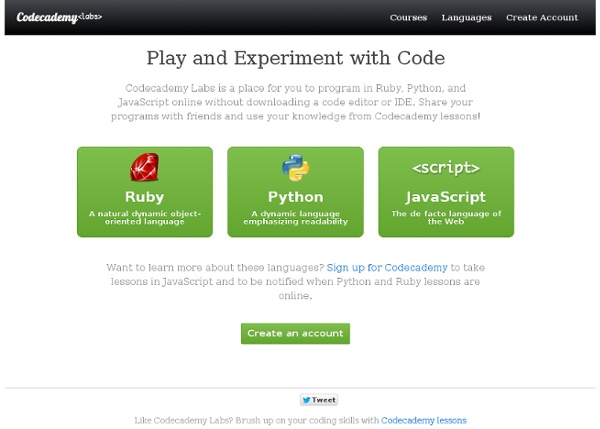Aptana Studio — Advanced Python 0.3 documentation
Aptana Studio is an IDE - integrated development environment - based on the Eclipse framework. It provides powerful tools for exploring, understanding, and refactoring your code. Because Aptana Studio is Eclipse + a plugin, in class I may refer to “Aptana” and “Eclipse” interchangeably. Aptana’s Python support was formerly a separate Eclipse plugin called PyDev. Workspace¶ When it starts up, Aptana will ask you what folder you want to use as a workspace. Instead use ~/workspace, the standard Eclipse workspace path. Harmless libjpeg Error¶ The first time you start Apatana Studio, you will get a frightening-looking error message, complaining that libjpeg.62.so is missing. Click OK, and Eclipse will ask if you want to exit. This bug can be avoided entirely by installing libjpeg62: $ sudo apt-get install libjpeg62 However this is not strictly necessary, as the bug does not damage anything, and appears only the first time a new Apatana installation is run. Installing Eclipse Plugins¶ Vwrapper¶
Editors
If you have anything to contribute -- e.g. configurations for editors, new editors, or opinion -- don't hesitate to edit or create pages. There's an EditorConfigurationHowto available. Please keep wiki links as wiki links, use external links only if there is no existing page for the editor. Please add pages like BoaConstructor also to page IntegratedDevelopmentEnvironments. Multiplatform Editors Unix-Only Editors Windows-Only Editors Macintosh-Only Editors Online Editors Glorified Editors "IDEs" that don't integrate anything Python-specific go here. Enhanced Python shells Mobile Device Editors "IDEs" that run on mobile devices and tablets. Other Resources PySmell provides autocompletion for Vim, Emacs and TextMate Never ending debate EmacsVsVi CategoryEditors
Les docstrings en Python | Sam & Max
Du fait de la nature du tuto, exceptionellement je ne respecterai pas le nouveau format de rédaction. Mais y aura quand même de la zik : Une des mes fonctionnalités favorites en Python est son mécanisme de documentation du code : les doctrings. Principe La docstring est une chaîne de caractères que l’on n’assigne pas, et qui est placée à un endroit spécifique du code pour décrire ce dernier. La docstring la plus courante est placée sous une fonction. def ajouter(a, b): return a + b Et voici une fonction AVEC docstring : def ajouter(a, b): """ Ajoute deux nombres l'un à l'autre et retourne le résultat. """ return a + b La chaîne de caractère doit être placée juste en dessous de la signature de la fonction. Écrire des docstrings offrent de nombreux avantages : Usage Si vous avez une fonction ainsi faite : Alors dans un shell, toute personne qui va utiliser votre fonction pourra faire : #! On peut aussi documenter une classe et ses méthodes : Bonnes pratiques L’anglais est votre ami. Bref. Usage avancé
BulreZo : Système de bulletins scolaires à hautes performances
Ressources Python
Ressources didactiques Gérard Swinnen Vous trouverez ci-dessous : en téléchargement libre, les versions numériques de l'ouvrage "Apprendre à programmer avec Python" de Gérard Swinnen (troisième et cinquième éditions), anciennement publié aux éditions O'Reilly et dorénavant édité chez Eyrolles (ISBN 978-2-212-13434-6) ; le code source des exemples et exercices proposés dans le livre ;Les diapositives et le code source des exemples présentés par G.Swinnen au colloque "Libr'East of Paris" (IUT de Marne-la-vallée) les 23 & 24 Avril 2004 ;Les diapositives de la conférence sur Python présentée à l'IUT de Vannes (Université de Bretagne Sud), le 15 Avril 2005 ;La traduction du livre en hongrois (+ lien vers le site web du traducteur).La traduction du livre en arabe (+ lien vers le site web des traducteurs). Les deux dernières éditions traitent de la version 3 de Python. Au sommaire : Préface. *** Traduction hongroise *** Merci infiniment, Péter ! *** Traduction arabe *** ... Téléchargements
Automate the Boring Stuff with Python | Practical Programming for Total Beginners
No, Seriously, Why Should I Learn to Code? | The “Invent with Python” Blog
The geeks have inherited the earth. A couple decades ago if you talked with friends in a chat room, you were cast as a socially-awkward nerd. Doing the same today just means you're a typical Facebook user. Broadband Internet connections and smartphones have taken the Information Age that technically started in the 1970s with PCs and pushed it into daily mainstream life. Along with this culture change is a social anxiety: Should I learn to code? Like with all panics, entrepreneurs and pundits (including myself) come out of the woodwork to offer their opinions or push their products. Don't get me wrong: You should learn to program. Here are bogus reason you should learn to code that you'll find in most everyone-should-learn-to-code rhetoric: To become a software engineer and make six-figures. Before I go into the real reasons you, your friends, your neighbors, your cat, and everyone should indeed learn to code, consider this anecdote: "But," the teacher continued, "let me ask you this.
Pyjs
Skulpt
Pyjeon Software



